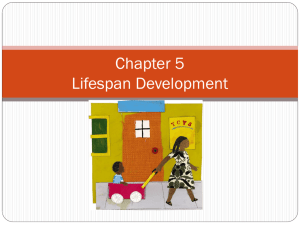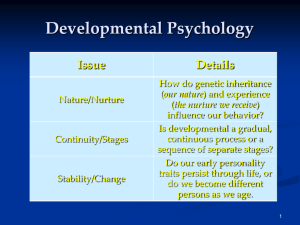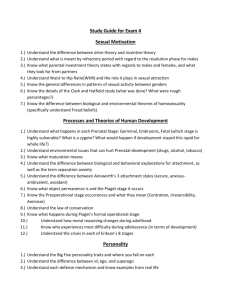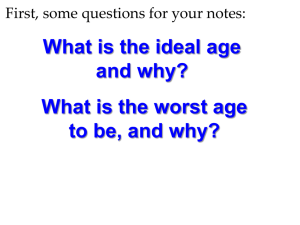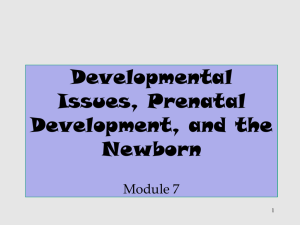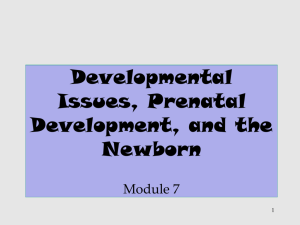Memory
advertisement
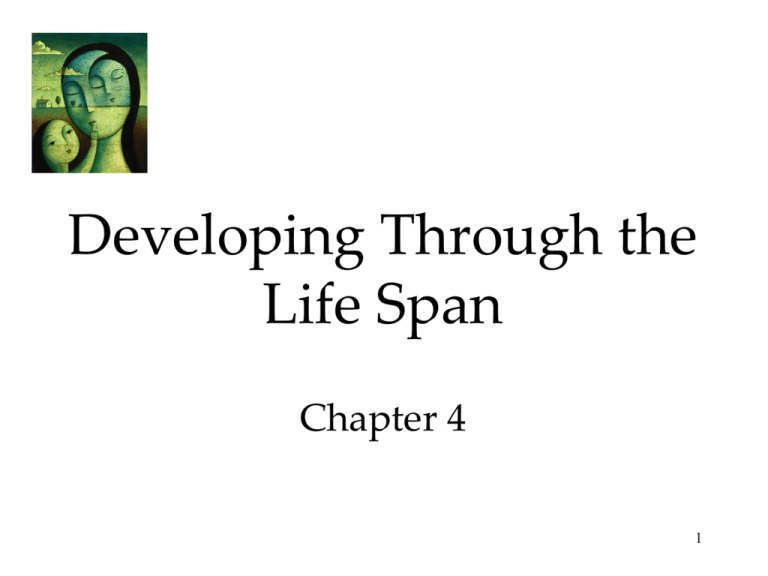
Developing Through the Life Span Chapter 4 1 Developing Through the Life Span Prenatal Development and the Newborn Conception Prenatal Development The Competent Newborn Infancy and Childhood Physical Development Cognitive Development Piaget’s Cognitive Development Theory 2 Developmental Psychology Developmental Psychologist examines how people are continually developing, physically, cognitively, and socially, from infancy though old age. 3 Prenatal Development and the Newborn How, over time, did we come to be who we are? From zygote to birth, development progresses in an orderly, though fragile, sequence. 4 Conception A single sperm cell (male) penetrates the outer coating of the egg (female) and fuses to form one fertilized cell. Lennart Nilsson/ Albert Bonniers Publishing Company Lennart Nilsson/ Albert Bonniers Publishing Company 5 Prenatal Development: The Basics of Genetics 6 The Earliest Development • Germinal period – First two weeks – Zygote • The new cell that is formed by fertilization • Embryonic period – 2 to 8 weeks – Embryo • Rapid growth of the zygote that has developed a heart, brain, intestinal tract, and other organs 7 Prenatal Development A zygote is a fertilized egg with 100 cells that become increasingly diverse. At about 14 days the zygote turns into an embryo (a and b). Biophoto Associates/ Photo Researchers, Inc. Lennart Nilsson/ Albert Bonniers Publishing Company 8 Germinal Stage • This is a lateral view of a Zygot 0.8 hours Post Fertilization 9 Germinal Stage • A day or two after conception the zygot divides to two parts • This is a lateral view 40 hours after conception 10 Embryonic Stage • 2- 8 weeks after conception 11 Prenatal Development At 9 weeks, an embryo turns into a fetus (c and d). Lennart Nilsson/ Albert Bonniers Publishing Company Lennart Nilsson/ Albert Bonniers Publishing Company 12 The Earliest Development • Fetal period – Begins at the end of 8th week of pregnancy and ends with birth 13 Harmful Prenatal Environmental Influences are called Teratogens • Prenatal Risks or Teratogens – Viruses such as Rubella – Prescription Drugs—Thalidomide Babies – Alcohol, cigarette, cocaine 14 Thalidomide History • Thalidomide appeared on the market in West Germany on October 1 1957 and was hailed as a safe and effective sleeping pill. Soon it became the drug of choice to help pregnant women combat the symptoms associated with morning sickness. Alcohol • Fetal Alcohol Syndrome (FAS) is the leading known cause of mental retardation in western civilization • Of all the substances of abuse, including heroin, cocaine, and marijuana, alcohol produces by far the most serious neurobehavioral effects in the fetus, resulting in lifelong permanent disorders of memory function, impulse control and judgment. (Institute of Medicine Report to Congress) • Over 50% of women of childbearing age drink alcohol. (American Medical Association) And only 39% of women of childbearing age even know what FAS is. (National Institute of Health) • About 20% of women who are known to be pregnant continue to drink during their pregnancy. (Journal of American Medical Association) The incidence of drinking during pregnancy has increased substantially in the past several years, possibly due to the misleading media message that a drink a day is healthy. (Center for Disease Control and Prevention) Alcohol • At least 5,000 infants are born each year in the U.S. with full Fetal Alcohol Syndrom or FAS • Persons with FAS have serious problems with attention deficits, impulse control, judgment, and memory • Among children with FAS up to age 15, the social maturation process seems to be stunted at the level of a 6 year old child. • Fewer than 10% of individuals with FAS are able to achieve success in living and working FAS Abilities of Newborn • • • • • Reflexes Vision Visual preferences Smell and taste Hearing 19 The Competent Newborn Infants are born with reflexes that aid in survival, including rooting reflex which helps them locate food. 20 Reflexes 21 Vision Birth 1 mont h 3 mont h 6 mont h Physical Development Developing brain At birth, most brain cells are present. After birth, the neural networks multiply resulting in increased physical and mental abilities. Maturation. The development of the brain unfolds based on genetic instructions, causing various bodily and mental functions to occur in sequence— standing before walking, babbling before talking 23 Motor Development First, infants begin to roll over. Next, they sit unsupported, crawl, and finally walk. Experience has little effect on this sequence. Profimedia.CZ s.r.o./ Alamy Phototake Inc./ Alamy Images Jim Craigmyle/ Corbis Renee Altier for Worth Publishers 24 Maturation and Infant Memory The earliest age of conscious memory is around 3½ years (Bauer, 2002). A 5-year-old has a sense of self and an increased long-term memory, thus organization of memory is different from 3-4 years. Courtesy of Carolyn Rovee-Collier Amy Pedersen 25 Cognitive Development Piaget believed that the driving force behind intellectual development is our biological development amidst experiences with the environment. Our cognitive development is shaped by the errors we make. Both photos: Courtesy of Judy DeLoache 26 Schemas Schemas are mental molds into which we pour our experiences. 27 Assimilation and Accommodation Bill Anderson/ Photo Researchers, Inc. The process of assimilation involves incorporating new experiences into our current understanding (schema). The process of adjusting a schema and modifying it is called accommodation. Jean Piaget with a subject 28 Piaget’s Theory and Current Thinking 29 Sensorimotor Stage In the sensorimotor stage, babies take in the world by looking, hearing, touching, mouthing, and grasping. Children younger than 6 months of age do not grasp object permanence, i.e., objects that are out of sight are also out of mind. Doug Goodman 30 Sensorimotor Stage: Criticisms Piaget believed children in the sensorimotor stage could not think —they do not have any abstract concepts or ideas. However, recent research shows that children in the sensorimotor stage can think and count. 1. Children understand the basic laws of physics. They are amazed at how a ball can stop in midair or disappear. 31 Sensorimotor Stage: Criticisms 2. Children can also count. Wynn (1992, 2000) showed that children stared longer at the wrong number of objects than the right ones. 32 Preoperational Stage Piaget suggested that from 2 years old to about 6-7 years old, children are in the preoperational stage—too young to perform mental operations. Ontario Science Center 33 Preoperational Stage: Criticism DeLoache (1987) showed that children as young as 3 years of age are able to use mental operations. When shown a model of a dog’s hiding place behind the couch, a 2½-year-old could not locate the stuffed dog in an actual room, but the 3-year-old did. 34 Egocentrism Piaget concluded that preschool children are egocentric. They cannot perceive things from another’s point of view. When asked to show her picture to mommy, 2year-old Gabriella holds the picture facing her own eyes, believing that her mother can see it through her eyes. 35 Concrete Operational Stage In concrete operational stage, given concrete materials, 6- to 7-year-olds grasp conservation problems and mentally pour liquids back and forth into glasses of different shapes conserving their quantities. Children in this stage are also able to transform mathematical functions. So, if 4 + 8 = 12, then a transformation, 12 – 4 = 8, is also easily doable. 36 Formal Operational Stage Around age 12, our reasoning ability expands from concrete thinking to abstract thinking. We can now use symbols and imagined realities to systematically reason. Piaget called this formal operational thinking. 37 Formal Operational Stage Rudiments of such thinking begin earlier (age 7) than what Piaget suggested, since 7-year-olds can solve the problem below (Suppes, 1982). If John is in school, Mary is in school. John is in school. What can you say about Mary? 38 Reflecting on Piaget’s Theory Piaget’s stage theory has been influential globally, validating a number of ideas regarding growth and development in many cultures and societies. However, today’s researchers believe the following: 1. Development is a continuous process. 2. Children express their mental abilities and operations at an earlier age. 3. Formal logic is a smaller part of cognition. 39 Social Development Stranger anxiety is the fear of strangers that develops at around 8 months. This is the age at which infants form schemas for familiar faces and cannot assimilate a new face. © Christina Kennedy/ PhotoEdit 40 Origins of Attachment Harlow Primate Laboratory, University of Wisconsin Harlow (1971) showed that infants bond with surrogate mothers because of bodily contact and not because of nourishment. 41 Mary Ainsworth Attachment Differences Placed in a strange situation, 60% of children express secure attachment, i.e., they explore their environment happily in the presence of their mothers. When their mother leave, they show distress. The other 30% show insecure attachment. These children cling to their mothers or caregivers and are less likely to explore the environment. 42 Insecure Attachment Harlow’s studies showed that monkeys experience great anxiety if their terry-cloth mother is removed. Harlow Primate Laboratory, University of Wisconsin 43 Temperament and attachment Relaxed and attentive caregiving becomes the backbone of secure attachment even when babies are diffcult. Berry Hewlett 44 Deprivation of Attachment What happens when circumstances prevent a child from forming attachments? In such circumstances children become: 1. Withdrawn 2. Frightened 3. Unable to develop speech 45 Prolonged Deprivation If parental or caregiving support is deprived for an extended period of time, children are at risk for physical, psychological, and social problems, including alterations in brain serotonin levels. 46
